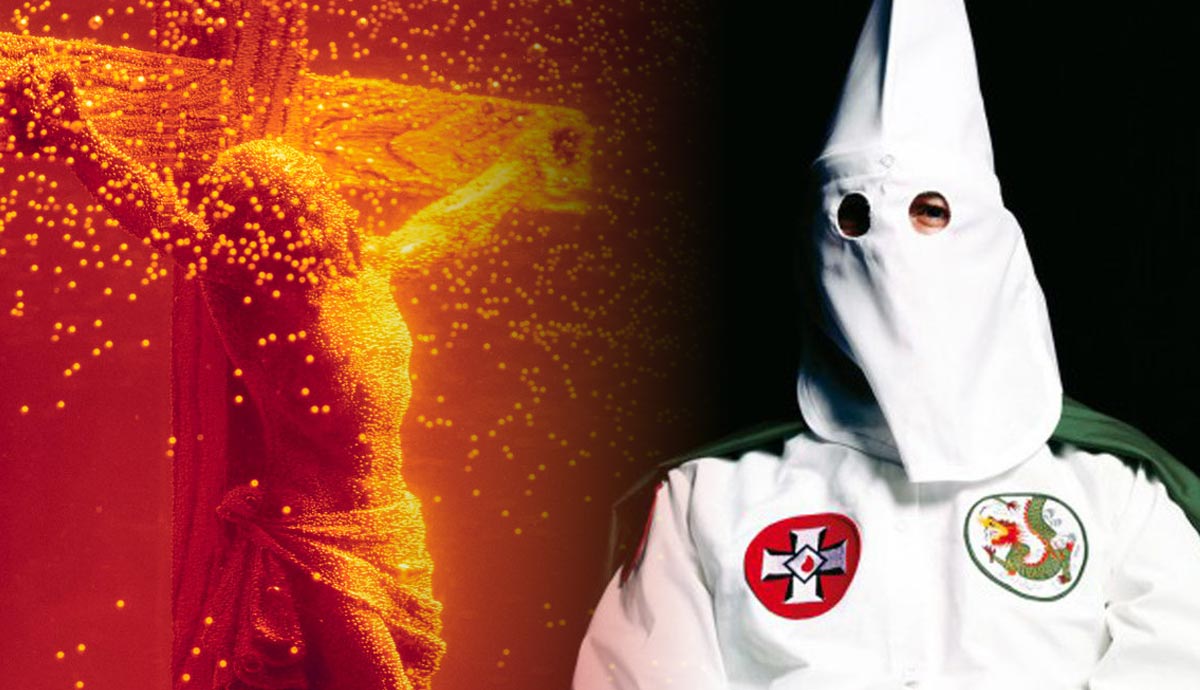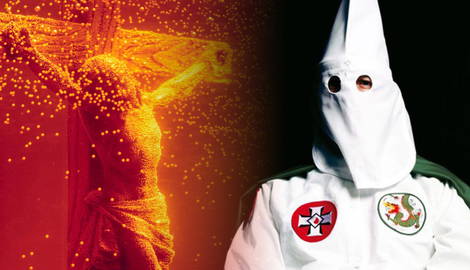
Born in New York in 1950, Andres Serrano is of Honduran and Afro-Cuban descent. He was raised as a Catholic, and religious ceremonies and iconography have had a huge impact on his life and art. He studied art at the Brooklyn Museum Art School from 1967 to 1969. During the 1970s he struggled with substance abuse and worked as a drug dealer. By the early 1980s, he had managed to return to his photographic practice. His work explores his Hispanic Roman Catholic childhood and his religious upbringing and beliefs.
1. Milk/Blood by Andres Serrano

Andres Serrano’s 1986 work Milk/Blood is a relatively simple yet profoundly effective work of art. This work uses bodily fluids as a primary medium, something which we see again and again throughout Serrano’s career. In Milk/Blood, he juxtaposes two very different yet intimately human substances—milk and blood—in a way that is both visually intriguing and rich in symbolic meaning.
The work consists of two panels, one filled with milk and the other with blood, placed side by side. These heavily symbolic materials evoke ideas of sustenance and death, of purity and contamination. Milk, the giver of life which is often associated with motherhood and childhood, is placed in contrast with blood, a fluid associated with violence, death, and disease. The work was made during the time when the AIDS epidemic was destroying communities across America. However, this binary opposition is complicated by the fact that blood is also the vital life force that runs through our veins each day. Like much of Serrano’s work, Milk/Blood defies easy categorization and simplistic readings.
Milk/Blood explores the intricacies of the human body and its biological functions, which are often considered taboo in the context of art. By elevating these substances to the level of fine art, Serrano challenges societal norms and perceptions about what is seen as acceptable or beautiful. This work, like much of his art, blurs the lines between the sacred and the profane, the pure and the defiled, encouraging a reevaluation of these concepts.
2. Immersion (Piss Christ)

Serrano’s most famous work called Immersion (Piss Christ) also uses bodily fluids to create an image that is both beautiful and shocking. A crucifix hangs, suspended in a reddish/orange glow. A smattering of air bubbles hints that the cross is submerged, perhaps preserved in resin like an ancient amber artifact. The title, however, tells us the truth of the image: the crucifix is immersed in urine. Urine is a substance associated with uncleanliness, disdain, disrespect, and even shame—hence the controversy that surrounds this work of art.
Although initially well received, the work faced backlash after it won an award sponsored by the National Endowment for the Arts (NEA). Because the NEA is an agency of the American government, certain senators felt that it was inappropriate for such an offensive work of art to receive state funding. As a result, a law was passed that required the NEA to consider general standards of decency in subsequent grant awards. Serrano received hate mail and death threats, and the NEA budget was reduced by two-fifths. This work can in many ways be seen as the work which sparked the culture wars which loomed over America in the 1980s and 1990s.
Serrano has mentioned that the work represents the crucifixion of a man who was tortured, humiliated, and left to die on a cross for several hours. One reading of this work, then, is that the use of urine in this piece serves to shock the viewer, in the hope that they may find themselves closer to the humanity of Christ’s suffering.
3. The Morgue

In this series of photographs, taken in 1992, Serrano takes us into the somber and hidden world of the morgue, presenting a collection of images that are both haunting and deeply humanizing. The series consists of over 20 photographs, each featuring an unidentified corpse, and each titled with the cause of death such as Gunshot Wound to the Head or Infectious Pneumonia.
Serrano approaches his subjects with a frank gaze. The images are stark and unflinching, yet they are handled with a level of respect and dignity that elevates them above mere shock value. In this way, these photographs encourage us to confront the realities of death and the fragility of human life.
The titles and the often disturbing state of these bodies speak to wider social issues of violence, neglect, aging, and disease. Serrano uses shock to startle or move the viewer into an emotional state, from where they can connect with the suffering of these individuals, and reflect on the systems and circumstances that led to their deaths. In each portrait, we are frightened to see our own possible futures, and so consider our own mortality.
4. A History of Sex

Photographed throughout 1995-1996, the History of Sex series explores the vast realm of human sexuality, through portraits that are shocking, beautiful, and tender. In over 50 photographs, Serrano portrays a variety of different bodies and sexual acts, providing a frank glimpse into the private lives of his subjects. These portraits are a bold examination of the diverse expressions of human sexuality, transcending cultural, historical, and societal norms.
Serrano’s approach is both artistic and anthropological, documenting sexual acts and preferences without judgment or censorship. The series includes images of heterosexual and homosexual couples, group encounters, and a variety of fetishes and kinks, presented with a raw honesty that is both jarring and enlightening. The series was met with significant controversy from both within and outside the art world.
Critics argued that the works were pornographic and inappropriate for public exhibition, while Serrano maintained they were an exploration of the diversity of human sexuality. The series was subject to censorship and protests, particularly when displayed in public galleries. In many ways, the reaction to the series is integral to its impact, underscoring the power of art to provoke and challenge. Through this series, Serrano not only documents sexual practices but also opens up a space for conversation and reflection on the often hidden or repressed aspects of sexuality.
5. The Klan

In this extremely jarring collection, Serrano presents us with up-close portraits of members of the Ku Klux Klan, one of America’s most infamous hate groups. In each image, the sitter is presented in full ceremonial regalia, their eyes peering out from ragged eye holes, staring defiantly into the camera. What makes The Klan particularly compelling is the inherent contrast between the human and the inhuman. The robes and hoods anonymize the individuals, turning them into symbols of hatred and bigotry. Yet, glimpses of humanity peek through—a pair of eyes, the way someone stands, a hand gesture—reminding us that these are real people with complex histories and motivations. This duality creates a disconcerting tension.
Serrano himself said that although photographing these people was difficult, he had to endure their racist comments aimed at him throughout the process. However, he did feel some compassion for these individuals and empathized with their difficult lives. His goal was not to glorify or vilify his subjects but instead to offer a dispassionate portrayal that would prompt reflection and discourse. By bringing members of the KKK into the open, honest light of portraiture, Serrano challenges viewers to consider the lived reality of hate and evil and to question the social and cultural factors that perpetuate such ideologies.
6. Residents of New York by Andres Serrano

A less controversial but notable work in Serrano’s career is Residents of New York. Created in 2014, this series turns a compassionate and dignified eye on the diverse homeless community of New York City. The portraits are intimate and honest, and treat each individual with respect and tenderness. The series was displayed in various public locations around New York City, including outdoor spaces and subway stations, making the art both accessible and impactful to a broad audience. By displaying these images in public spaces, Serrano attempted to bring these people from the margins into the center, highlighting issues of visibility and belonging.
Throughout his career, Andres Serrano has pushed the limits of what people consider art. In his shocking and honest photographs, he explores aspects of our culture and our psyche that are often repressed or ignored. The works from this series remind us how easy it is to overlook those less fortunate than us. Serrano encourages a deeper understanding and awareness of the struggles faced by many and fosters a sense of community and compassion in the heart of one of the world’s busiest cities.










